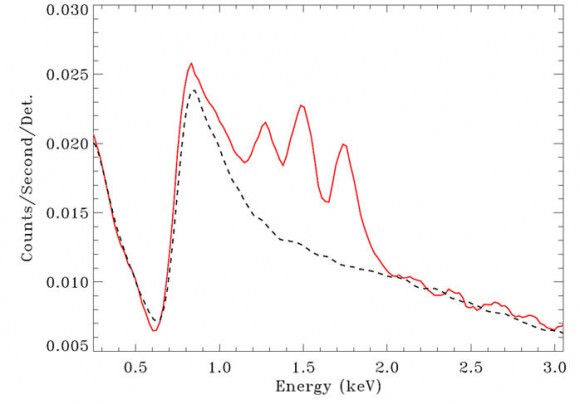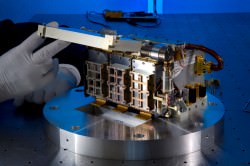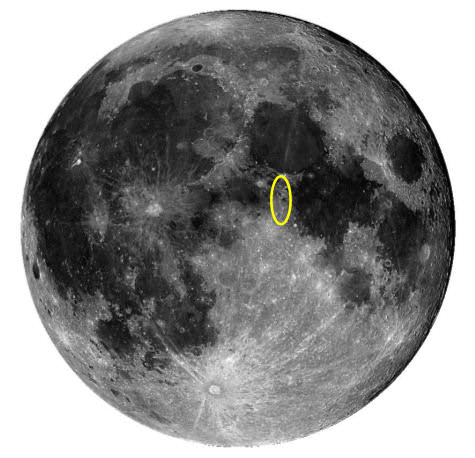[/caption]
The X-ray instrument on board the Chandrayaan-1 spacecraft orbiting the moon was switched on and successfully detected its first X-ray signature from the moon. The C1XS X-ray camera, (pronounced like “kicks”) detected the X-ray signal from a region near the Apollo landing sites on December 12th 2008 at 02:36 UT. The solar flare that caused the X-ray fluorescence was exceedingly weak, approximately 20 times smaller than the minimum C1XS was designed to detect, which is good news for the sensitivity of the instrument. “C1XS has exceeded expectations as to its sensitivity and has proven by its performance that it is the most sensitive X-ray spectrometer of its kind in history,” said Ms. Shyama Narendranath, Instrument Operations Scientist at the Indian Space Research Organisation (ISRO).
The instrument will help map out the composition of the Moon in much greater detail than has ever been done, and could help settle a long-running debate about how the Moon formed.
The leading theory of how the Moon was created is that a Mars-sized object slammed into the Earth early in its history, creating our orbiting moon. A better accounting of the Moon’s makeup is needed to solidify the theory.
A few other spacecraft, like Chandra have taken X-ray images of the moon, but X-ray imaging from Earth is impossible because our atmosphere cuts out X-rays from space.
The C1XS will work by looking at the X-rays from our sun that have been absorbed by atoms in the lunar soil, then re-emitted in such a way as to reveal the chemistry of the surface. The spectrometer is sensitive to magnesium, aluminium and silicon x-rays.

The X-ray camera collected 3 minutes of data from the Moon just as the flare started and the camera finished its observation. The signal reveals the X-ray fingerprint of a part of the lunar surface. As the mission continues, C1XS will build up a detailed picture of the ingredients that have gone into the Moon.
Barry Kellett, instrument scientist from the UK’s Science and Technologies Facilities Council said, “Despite the small quantity of data, our initial analysis and modeling shows that C1XS has identified the chemistry of this area of the Moon.”

The instrument was jointly developed by the UK’s STFC Rutherford Appleton Laboratory and ISRO.
Professor Richard Holdaway, Director of STFC’s Space Science and Technology Department, said, “We are thrilled that C1XS has started its mission so successfully and is exceeding expectations. This sophisticated instrument will not only help us better understand the origin of the Earth-Moon system but will ensure that the UK plays an important role in this international activity.”
Source: STFC


Glad to see british stuff leading the way as usual ;/
Mighty britain etc
Great to read that D1xs working well.
I know Barry Kellett of RAL I am aware that getting results based on X ray output from the Sun is going to be difficult during sunspot minimum.
The X ray technique being used is similar to that used in the research lab I came out of – there it is used to analysis silicate minerals.
Keep up the good work.
I already dream of surface mining activities at the Moon.
It would be interessting to find out what those red peaks in the diagram mean in reference to quantity, distribution of the minerals magnesium, aluminium and silicon. The three peaks nearly have the same size. Does that mean that the three minerals have the same concentration in that area.
The yellow mark on the picture above comprises quite a large area. What is the resolution of this measurement?
Hi Dollhopf,
It doesn’t mean that three elements are in the same concentration in that area. X-ray line flux is dependent on many parameters and is not simply proportional to concentration. It requires further work to arrive at elemental abundance.
The yellow mark shows the area covered for a few minutes duration and the data has been added. The resolution of the instrument is 25km (FWHM)
Dear Shyama!
Of course, I am an absolute dumbass in regard to this technology. I don’t mean this cynically. It is simply true. I don’t have any concept of the functionality of the method. But when I just play around with concepts that are familiar to me then I think the following:
would it not be helpful to send a probe to the surface of the Moon with a well outbalanced amount of magnesium, aluminium or silicon so that the C1XS X-ray camera could be calibrated by measuring this reference stuff? I mean, Chandrayaan already deployed a Moon Impact Probe. This probe could also have carried a reference sample to adjust the meter.